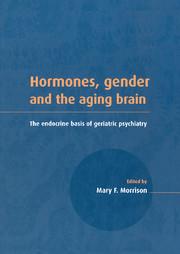Book contents
- Frontmatter
- Contents
- List of contributors
- Preface
- Acknowledgments
- Part I Overview
- 1 Summary chapter. The endocrine basis of geriatric psychiatry: an integrative approach
- 2 Overview of steroids in the aging brain
- Part II Hormones and mental health in the elderly
- Part III Effects of hormones and behavior on immune function
- Part IV Hormones and gender differences in psychotropic drug metabolism
- Index
2 - Overview of steroids in the aging brain
from Part I - Overview
Published online by Cambridge University Press: 18 September 2009
- Frontmatter
- Contents
- List of contributors
- Preface
- Acknowledgments
- Part I Overview
- 1 Summary chapter. The endocrine basis of geriatric psychiatry: an integrative approach
- 2 Overview of steroids in the aging brain
- Part II Hormones and mental health in the elderly
- Part III Effects of hormones and behavior on immune function
- Part IV Hormones and gender differences in psychotropic drug metabolism
- Index
Summary
Introduction
Steroid and thyroid hormones are often considered together because they share a similar cellular mechanism of action in their influence on neural structure and function. The nervous system is particularly sensitive to steroids and thyroid hormone during development, and these hormones also modulate neuronal and glial functions during adulthood. Aging-induced changes in these hormone systems are likely to influence physiological, cognitive, and emotional processes. Previously, it was believed that the effects of gonadal steroids on the adult nervous system were restricted to areas involved in reproduction; however, in recent years it has become evident that sex steroids affect other functions, such as learning and memory.
This chapter provides a review of the current understanding of the basic mechanisms of hormone effects in the brain, with an emphasis on the biosynthesis, the site of action, and the emerging diversity of cellular mechanisms employed by hormones to affect neuronal function.
Biosynthesis, release, and serum transport
Endocrine steroid synthesis
The precursor for all steroid biosynthesis is cholesterol, which can be derived from either animal fats in the diet or from local synthesis depending on the tissue. Specific cell-surface receptors bind circulating low-density lipoproteins that are rich in cholesterol. The protein–cholesterol complex then is transported into the cell by endocytosis, and the cholesterol is split from the lipoprotein, esterified, and stored in cytoplasmic vacuoles.
- Type
- Chapter
- Information
- Hormones, Gender and the Aging BrainThe Endocrine Basis of Geriatric Psychiatry, pp. 15 - 34Publisher: Cambridge University PressPrint publication year: 2000



